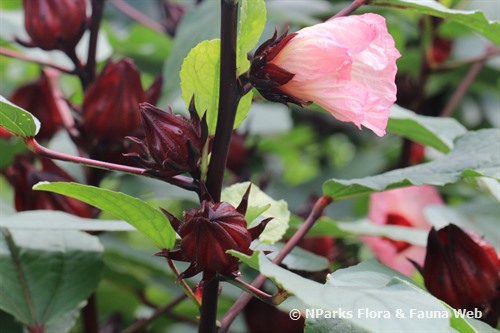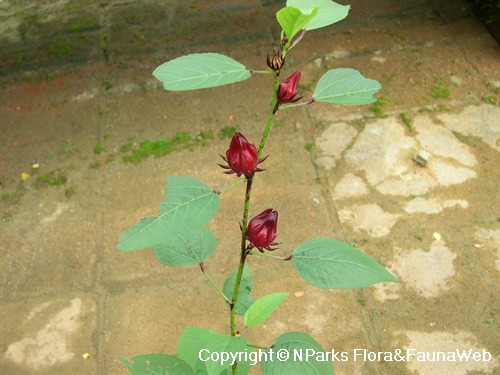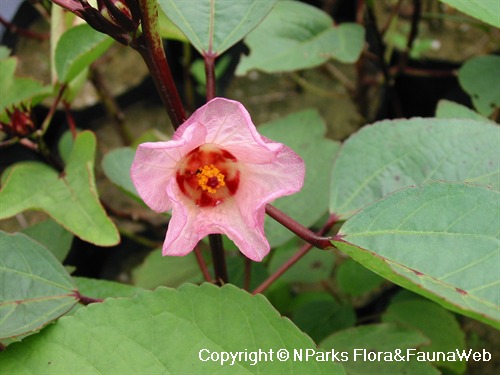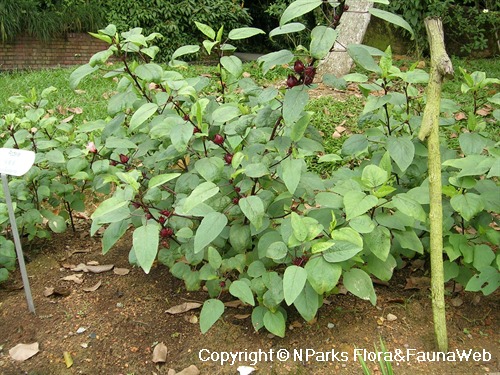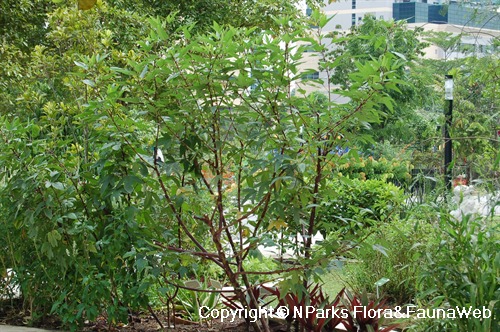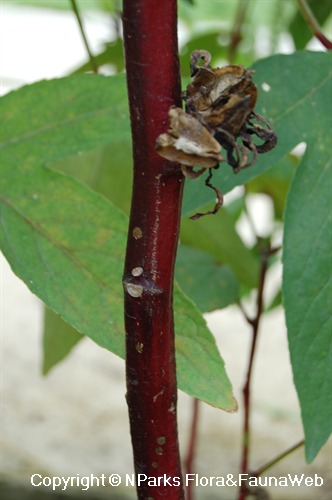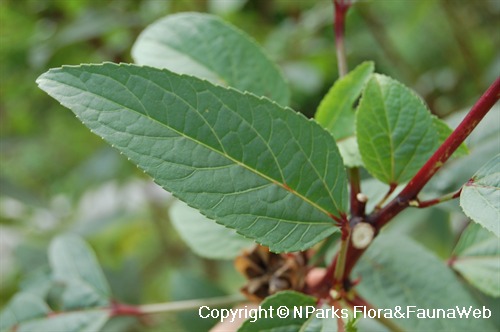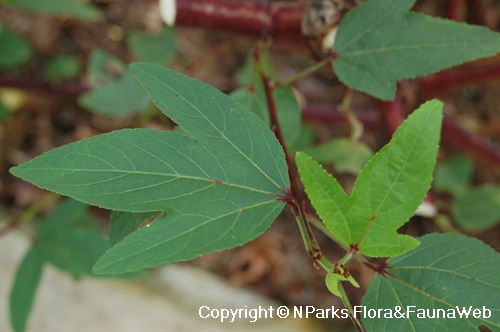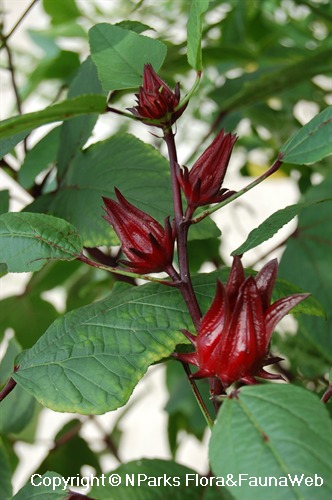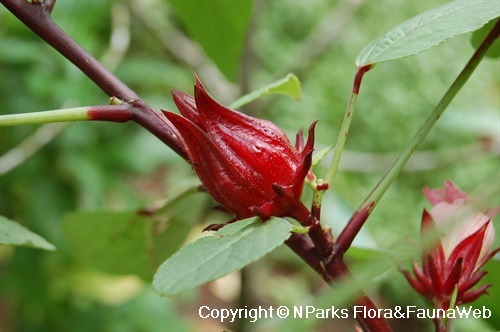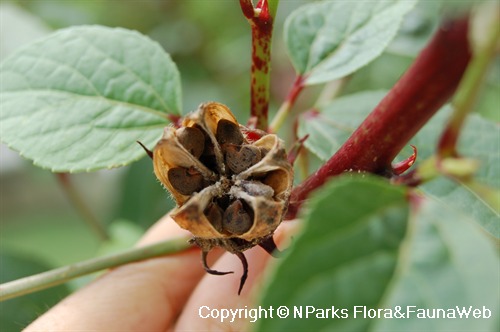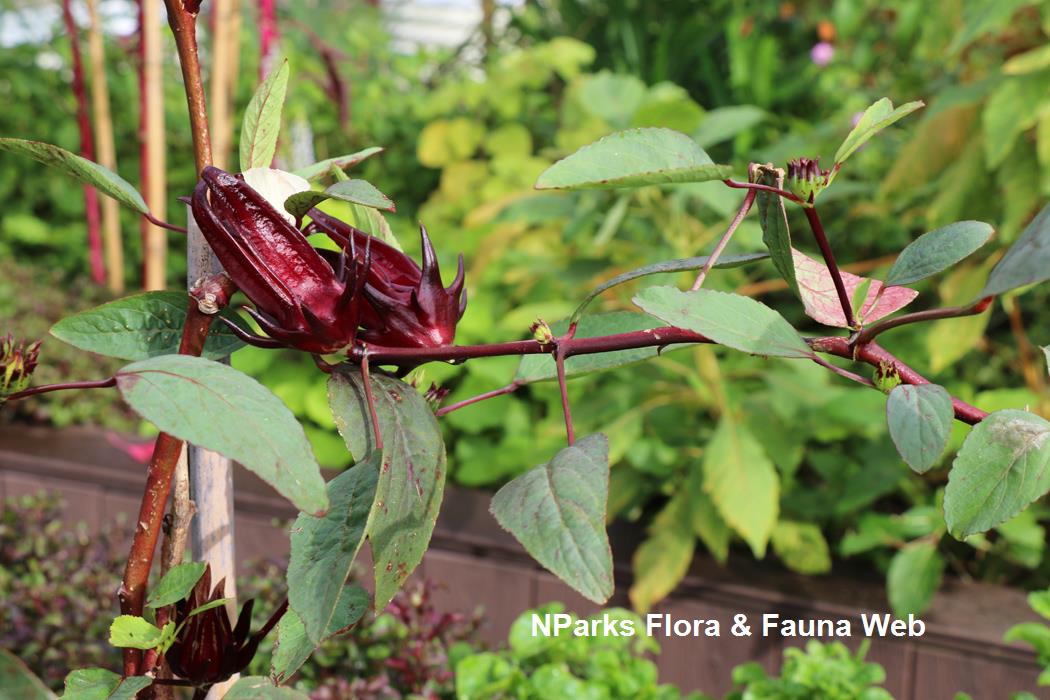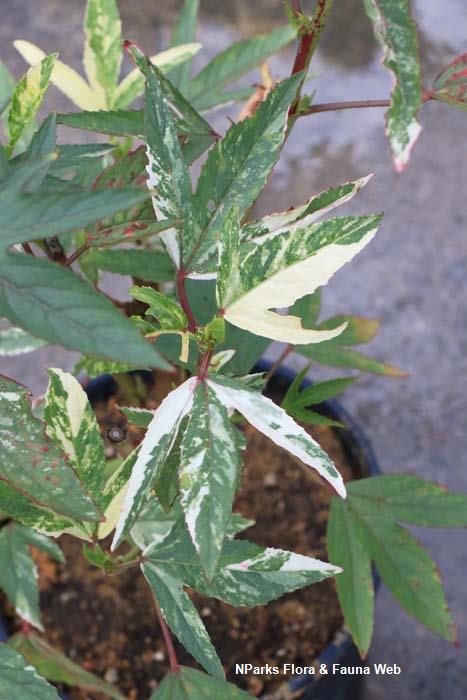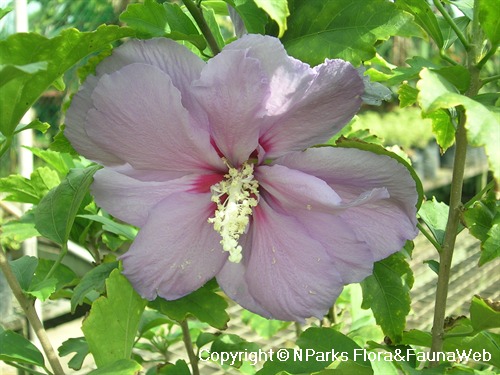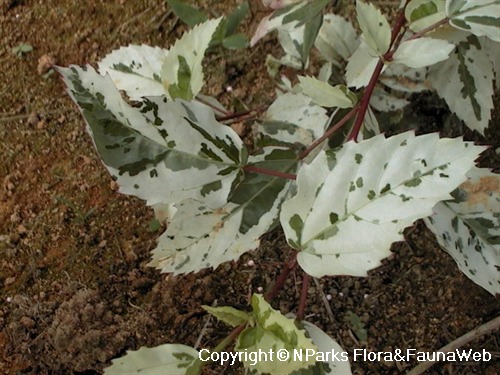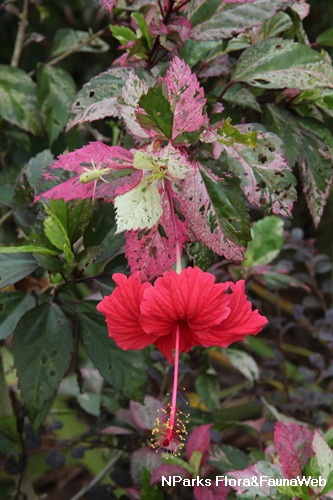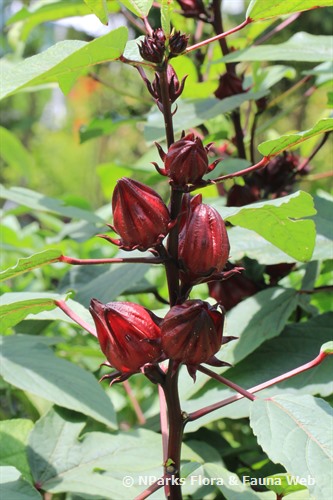
Back
Hibiscus sabdariffa L.
| Family Name: | Malvaceae |
| Synonyms: | Hibiscus gossypiifolius, Abelmoschus cruentus, Hibiscus digitatus, Sabdariffa rubra, Hibiscus sanguineus |
| Common Name: | Roselle, Jamaica Sorrel, Red Sorrel, Sorrel, Indian Sorrel, Asam Susar, 玫瑰茄, 山茄子 |
Roselle (Hibiscus sabdariffa) is a popular relative of the Lady's Finger, where its fleshy red calyces are commonly used in making jams and beverages with blackcurrant-like taste. Easily grown from stem cuttings or seeds, this sun-loving shrub can be planted on the ground or in containers where it receives at least 6 hours of sunlight daily. This plant has ornamental pinkish flowers and trilobed leaves making it an excellent hedge or border plant.
Name
Classifications and Characteristics
| Plant Division | Angiosperms (Flowering Seed Plants) (Dicotyledon) |
|---|---|
| Plant Growth Form | Shrub |
| Lifespan (in Singapore) | Perennial |
| Mode of Nutrition | Autotrophic |
| Maximum Height | 1 m to 2 m |
Biogeography
| Native Distribution | Central African Republic, Chad, Congo, Gabon, Ghana, Nigeria, Sudan, Zaire |
|---|---|
| Native Habitat | Terrestrial |
| Preferred Climate Zone | Tropical |
| Local Conservation Status | Non-native (Horticultural / Cultivated Only) |
Description and Ethnobotany
| Growth Form | Woody, perennial shrub with an erect form, able to grow up to 1 - 2 m tall. |
|---|---|
| Foliage | Dark green leaves are either lanceolate (3 - 7 cm wide, 11 - 16 cm long) or tri-lobed (19 - 20 cm wide, 15 - 16 cm long) with serrate leaf margins. Tri-lobed leaves are deeply lobed. The same individual may produce both leaf types. |
| Stems | The stem is woody and red to purple. |
| Flowers | Pinkish flowers (8 cm wide) have a red spot in the center, bright red, fleshy calyx enclosing the base of the flower. |
| Fruit | Dehiscent, dry fruit is classified as a capsule. It releases many brown, bean-shaped and wrinkled seeds (0.6 cm wide). |
| Cultivation | Plant this species in well-drained, slightly acidic soil (pH = 5 - 6.5) that is rich in organic matter and moisture retentive. Flowering occurs 45 - 60 days from seed planting. Calyces are ready for harvest about 35 days after flower opening. Prune the shrub to promote branching. Hard pruning will encourage the formation of larger flowers. This species is susceptible to root knot nematodes (Meloidogyne spp.). Mulching the plant and re-planting from seed in new areas will help to control the nematode population. Other problems include bacterial diseases caused by Xanthomonas campestris pv. malvacearum and Pseudomonas cihorii. These diseases can be controlled by keeping the foliage dry and spraying with chemicals such as mancozeb or copper sulfate pentahydrate. Plants are also prone to attack by whiteflies and two-spotted mites which can be sprayed with insecticidal soaps and horticultural oils. Stem and root rot can be a serious problem. |
| Etymology | Genus Hibiscus is from the Greek word hibiskos which Roman poet Virgil used to relate to the marsh mallow plant. Species epithet sabdariffa is the name of a genus that this species was once placed in. The common name "Roselle" is likely a corrupted version of the French name for this plant, "Oseille de Guinée," which means Guinea Sorrel. |
| Ethnobotanical Uses | Edible Plant Parts : Edible Flowers, Edible Leaves Food (Fruit or Vegetable): The young shoots have a sour taste. They can be consumed raw or cooked and may be added to salads, soups and meat or vegetable dishes. Fresh or dried calyces can be immersed in hot water and then sweetened with sugar to prepare a beverage that is rich in antioxidants, such as Vitamin C and anthocyanins. Its taste is similar to Ribena (a blackcurrant-flavored drink). In the Caribbeans, people drink the juice extracted from the calyces either fresh or fermented. The versatile calyx is also used as a natural food coloring, as well as for making jams which taste like cranberry sauce. Medicinal: Scientific Evidence of Medicinal Properties In both pre-clinical and clinical trials, Roselle showed antioxidant (Usoh et al., 2012; Frank et al., 2012) and cholesterol-lowering properties (Usoh et al., 2012; Hajifaraji et al., 2018) in animals and people, respectively. In pre-clinical trials, Roselle showed pain-relieving (Ali et al., 2013), anti-cancer (Huang et al., 2018), anti-diabetic (Ndarubu et al., 2019), anti-inflammation (Ali et al., 2013), anti-microbial (Portillo-Torres et al., 2022) properties in animals. Traditional Medicinal Uses Research supports the traditional use of Roselle to treat ulcers. It is important to note that some therapeutic effects from traditional medicinal uses of plants are not currently supported or verified by scientific research. Cut - Dried Flower: This species produces a large number of attractive, red flower buds. These buds, as well as flowers that have bloomed, could be used as part of a floral arrangement. |
Landscaping Features
| Landscaping | This species makes as excellent hedge or border plant. The reddish stems and flower buds add colour to the landscape and also provide contrast against the dark green colour of the leaves. The tri-lobed leaves also help to give this shrub a unique appearance. Plant several individuals together to maximize the impact of its colour. |
|---|---|
| Desirable Plant Features | Ornamental Flowers |
| Landscape Uses | Parks & Gardens, Small Gardens |
| Thematic Landscaping | Economic Garden |
Fauna, Pollination and Dispersal
| Pollination Method(s) | Abiotic (Self-Pollinated) |
|---|---|
| Seed or Spore Dispersal | Abiotic |
Plant Care and Propagation
| Light Preference | Full Sun |
|---|---|
| Water Preference | Moderate Water |
| Plant Growth Rate | Fast to Moderate |
| Rootzone Tolerance | Moist Soils, Well-Drained Soils |
| Transplanting Tolerance | Moderate |
| Maintenance Requirements | Low |
| Diseases | Root rot, stem rot |
| Pest(s) | Nematodes, Sucking Insects |
| Propagation Method | Seed, Stem Cutting |
| Planting Distance | 60 cm |
Foliar
| Foliage Retention | Evergreen |
|---|---|
| Mature Foliage Colour(s) | Green |
| Mature Foliage Texture(s) | Smooth, Raised / Sunken Veins |
| Prominent Young Flush Colour(s) | Green |
| Young Flush Texture(s) | Raised / Sunken Veins |
| Foliar Type | Simple / Unifoliate |
| Foliar Arrangement Along Stem | Alternate |
| Foliar Attachment to Stem | Petiolate |
| Foliar Shape(s) | Non-Palm Foliage (Ovate, Palmate) |
| Foliar Venation | Pinnate / Net |
| Foliar Margin | Serrate / Toothed |
| Foliar Apex - Tip | Acute |
| Foliar Base | Acute |
| Leaf Area Index (LAI) for Green Plot Ratio | 4.5 (Shrub & Groundcover - Dicot) |
Non - Foliar and Storage
| Branch Angle (wrt vertical) | Woody |
|---|---|
| Trunk Type (Non Palm) | Woody |
| Stem Type & Modification | Woody |
| Root Type | Underground (Tap Root) |
Floral (Angiosperm)
| Flower & Plant Sexuality | Bisexual Flowers |
| Flower Colour(s) | Pink |
|---|---|
| Flower Texture(s) | Smooth |
| Flower Grouping | Solitary |
| Flower Location | Axillary |
| Flower Symmetry | Radial |
| Individual Flower Shape | Bowl-shaped |
| Flowering Period | Free-Flowering |
| Flowering Opening Time | Daytime |
| Flowering Habit | Polycarpic |
| Flower Size | 8 cm x 8 cm |
Fruit, Seed and Spore
| Mature Fruit Colour(s) | Red |
|---|---|
| Mature Fruit Texture(s) | Smooth |
| Fruit Classification | Simple Fruit |
| Fruit Type | |
| Mature Seed Colour(s) | Brown, Black |
| Mature Seed Texture(s) | Wrinkled |
| Seed Quantity Per Fruit | Several (11-20) |
References
| References | Ali, S.A.E., Mohamed, A.H. & Mohammed, G.E.E. (2014). Fatty acid composition, anti-inflammatory and analgesic activities of Hibiscus sabdariffa Linn. seeds. Journal of Advanced Veterinary and Animal Research 1(2): 50–57. Frank, T., Netzel, G., Kammerer, D.R., Carle, R., Kler, A., Kriesl, E., Bitsch, I., Bitsch, R. & Netzel, M. (2012). Consumption of Hibiscus sabdariffa L. aqueous extract and its impact on systemic antioxidant potential in helathy subjects. Journal of the Science of Food and Agriculture 92(10): 2207–2218. Hajifaraji, M., Matlabi, M., Ahmadzadeh-Sani, F., Mehrabi, Y., Rezaee, M.S., Hajimehdipour, H., Hasanzadeh, A. & Roghani, K. (2018). Effects of aqueous extracts of dried calyx of sour tea (Hibiscus sabdariffa L.) on polygenic dyslipidemia: A randomized clinical trial. Avicenna Journal of Phytomedicine 8(1): 24–32.
Huang, C.C., Hung, C.H., Chen, C.C., Kao, S.H. & Wang, C.J. (2018). Hibiscus sabdariffa polyphenol-enriched extract inhibits colon carcinoma metastasis associating with FAK and CD44/c-MET signaling. Journal of Functional Foods 48: 542–550.
Ndarubu, T.A., Chiamaka, O.S., Alfa, S., Aishatu, M., Chinedu, O.E., Wenawo, D.L, Adenike, A.R., Bashir, L. & Eustace, B.B. (2019). Phytochemicals, hypoglycemic and hypolipidemic effects of methanol leaf extract of Hibiscus sabdariffa in alloxan induced diabetic rats. GSC Biological and Pharmaceutical Sciences 8(3): 70–78. Portillo-Torres, L.A., Bernardino-Nicanor, A., Mercado-Monroy, J., Gómez-Aldapa, C.A., González-Cruz, L., Rangel-Vargas, E. & Castro-Rosas, J. (2022). Antimicrobial effects of aqueous extract from calyces of Hibiscus sabdariffa in CD-1 mice infected with multidrug-resistant enterohemorrhagic Escherichia coli and Salmonella typhimurium. Journal of Medicinal Food 25(9): 902–909. Usoh, I.F., Ekaidem, I.S., Etim, O.E., Akpan, H.D., Akpan, E.J. & Fakoya, A. (2012). Antioxidant and hepatoprotective effects of dried flower extracts of Hibiscus sabdariffa L. on rats treated with carbon tetrachloride. Journal of Applied Pharmaceutical Science 2(8): 186–189. |
|---|
Image Repository
Others
| Master ID | 801 |
|---|---|
| Species ID | 2096 |
| Flora Disclaimer | The information in this website has been compiled from reliable sources, such as reference works on medicinal plants. It is not a substitute for medical advice or treatment and NParks does not purport to provide any medical advice. Readers should always consult his/her physician before using or consuming a plant for medicinal purposes. |

.jpg)
.jpg)
